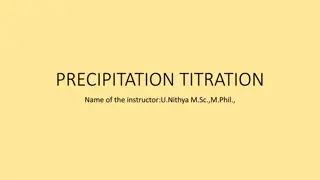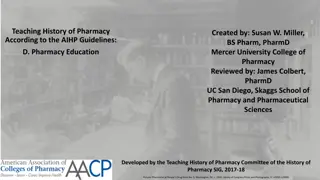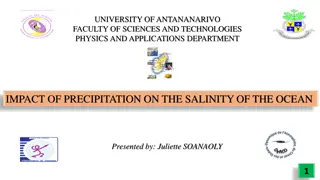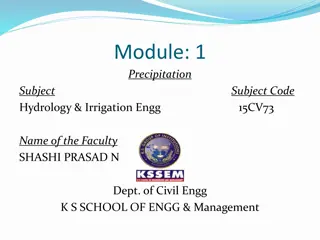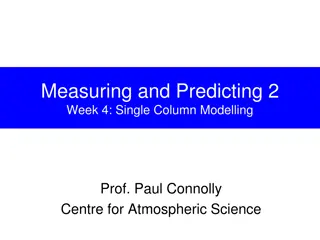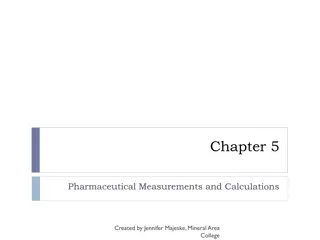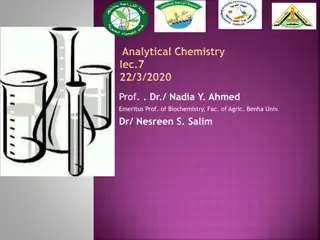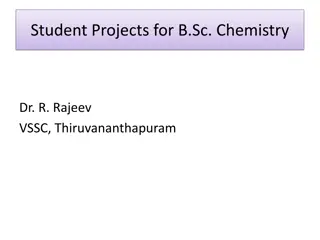Understanding Precipitation in Pharmacy and Chemistry
Precipitation is a crucial process in chemistry and pharmacy, where solid particles are separated from a clear liquid solution. This method is used for various purposes like obtaining fine particles, purifying powders, and preparing pharmaceutical substances. Examples include calcium carbonate, ammoniated mercury, and white lotion, all produced through precipitation reactions. The process involves the formation of a solid precipitate due to chemical reactions in solutions. It is utilized for purification and obtaining specific compounds in a finely divided form.
Download Presentation

Please find below an Image/Link to download the presentation.
The content on the website is provided AS IS for your information and personal use only. It may not be sold, licensed, or shared on other websites without obtaining consent from the author. Download presentation by click this link. If you encounter any issues during the download, it is possible that the publisher has removed the file from their server.
E N D
Presentation Transcript
Precipitation Precipitation is the process of separating solid particles from a previously clear liquid i.e a solution, by physical or chemical changes. The separated solid is termed a precipitate; the cause of precipitation is the precipitant; and the liquid that remains in the vessel above the precipitate is called the supernatant liquid.
Precipitation occurs when solutions of materials which react chemically are mixed to form a product which is but sparingly soluble in the liquid and therefore deposits out.
In pharmacy, precipitation may be useful for many purposes. To obtain fine particles: It provides a convenient method of obtaining solid substances in the form of fine particles (0.1 m in diameter or 100nm) i.e. precipitation of calcium carbonate (precipitated chalk).
Purification: It is also widely used as a method of purifying powders. The impure solid usually is dissolved in a suitable solvent at elevated temperatures. On cooling, the bulk of the impurities remain solubilized while the precipitates. This procedure is repeated as many times as necessary, using a number of solvents if required. purified solid product
Examples of pharmaceutical substances commonly prepared by precipitation are Calcium and magnesium carbonates made by treating the respective carbonate solution. Ammoniated mercury made by adding a solution of mercuric chloride to a solution of ammonia. Yellow mercuric oxide made by adding a warm solution of mercuric chloride to a solution of sodium hydroxide. chlorides with sodium
White Lotion is also prepared by precipitation. In this case aqueous solutions of zinc sulfate and sulfurated potash (HK4O3S3+) are mixed to form an insoluble, finely divided zinc sulfide, free sulfur, and various polysulfides. White solid precipitates of silver chloride are produced by adding aqueous silver nitrate to a solution of potassium chloride. AgNO3(aq) + Kcl (aq) Agcl (s) + KNO3(aq)
Types of precipitate The character of precipitate often depends upon the conditions under which it has been produced. When the reacting substances temperatures near to precipitate is usually granular and heavy, whereas; a precipitate of the same substance produced by mixing cold solutions may be light, take a long time to settle and to wash, and will pass through a filter. are mixed at their boiling-point, the
Similarly, concentrated solutions produce larger precipitates than do dilute solutions. Large, coarse precipitates can be readily freed from contaminating salts by washing. While small, fine precipitates may be difficult to free from impurities adsorbed on their large surface area.
Sometime the order of mixing the solutions can influence the type of precipitate i.e. When a solution of an iron salt is poured into an excess of a solution of sodium carbonate, iron carbonate Fe2(CO3)3is produced. But if the procedure is reversed the product will also contain basic salts such Fe(OH)(CO3)2etc., which may be difficult to remove. Fe(HCO3)3, as
Methods of separation Precipitates can be separated by filtration, decantation and centrifugation.









